Acura RLX HYBRID (2020 year). Manual in english — page 26
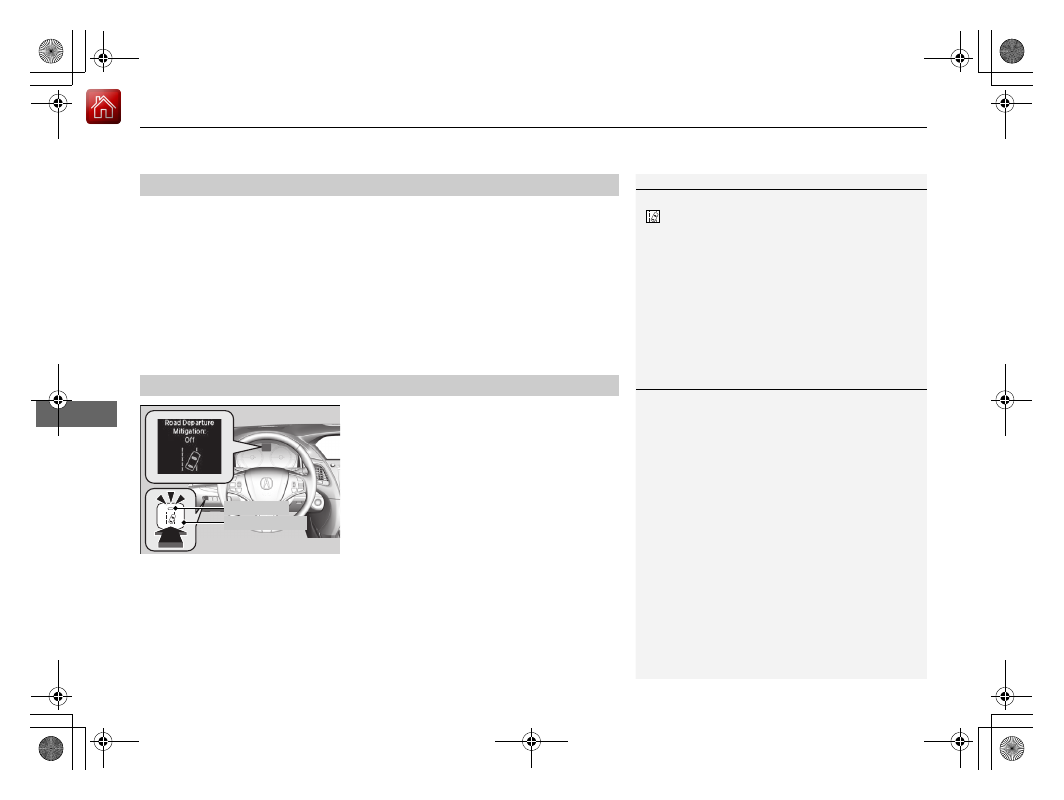
uu
When Driving
u
Road Departure Mitigation (RDM) System
418
Driving
The system becomes ready to start searching for lane markings when all the
following conditions are met:
•
The vehicle is traveling between 45 and 89 mph (72 and 144 km/h).
•
The vehicle is on a straight or slightly curved road.
•
The turn signals are off.
•
The brake pedal is not depressed.
•
The wipers are not in continuous operation.
•
The system makes a determination that the driver is not actively accelerating,
braking or steering.
Press the RDM button to turn the system on
and off.
u
The indicator in the button comes on and
the message appears on the multi-
information display when the system is
on.
■
How the System Activates
■
RDM On and Off
1
The RDM system may automatically shut off and the
indicator comes and stays on.
2
P. 76
RDM system function can be impacted when the
vehicle is:
•
Not driven within a traffic lane.
•
Driven on the inside edge of a curve, or outside of
a lane.
•
Driven in a narrow lane.
1
When you have selected
Warning Only
from the
customized options using the audio/information
screen, the system does not operate the steering
wheel and braking.
2
P. 295
RDM Button
Indicator
-------------------------------------------------------------------------------------------------------------------------------------------------------------
419
uu
When Driving
u
Road Departure Mitigation (RDM) System
Continued
Driving
The system may not properly detect lane markings and the position of your vehicle
under certain conditions. Some examples of these conditions are listed below.
■
Environmental conditions
•
Driving in bad weather (rain, fog, snow, etc.).
•
Sudden changes between light and dark, such as an entrance or exit of a tunnel.
•
There is little contrast between lane lines and the roadway surface.
•
Driving into low sunlight (e.g., at dawn or dusk).
•
Strong light is reflected onto the roadway.
•
Driving in the shadows of trees, buildings, etc.
•
Shadows of adjacent objects are parallel to lane markings.
•
Roadway objects or structures are misinterpreted as lane markers.
•
Reflections on the interior of the windshield.
•
Driving at night or in a dark condition such as a tunnel.
■
RDM Conditions and Limitations
-------------------------------------------------------------------------------------------------------------------------------------------------------------
420
uu
When Driving
u
Road Departure Mitigation (RDM) System
Driving
■
Roadway conditions
•
Driving on a snowy or wet roadway (obscured lane marking, vehicle tracks,
reflected lights, road spray, high contrast).
•
Driving on a road with temporary lane markings.
•
Faint, multiple, or varied lane markings are visible on the roadway due to road
repairs or old lane markings.
•
The roadway has merging, split, or crossing lines (e.g., such as at an intersection
or crosswalk).
•
The lane markings are extremely narrow, wide, or changing.
•
The vehicle in front of you is driving near the lane lines.
•
The road is hilly or the vehicle is approaching the crest of a hill.
•
Driving on rough or unpaved roads, or over bumpy surfaces.
•
When objects on the road (curb, guard rail, pylons, etc.) are recognized as white
lines (or yellow lines).
•
Driving on roads with double lines.
•
The road has ruts.
■
Vehicle conditions
•
Headlight lenses are dirty or the headlights are not properly adjusted.
•
The outside of the windshield is streaked or blocked by dirt, mud, leaves, wet
snow, etc.
•
The inside of the windshield is fogged.
•
The camera temperature gets too high.
•
An abnormal tire or wheel condition (wrong sized, varied size or construction,
improperly inflated, compact spare tire
*
, etc.).
•
The vehicle is tilted due to a heavy load or suspension modifications.
•
When tire chains are installed.
* Not available on all models
-------------------------------------------------------------------------------------------------------------------------------------------------------------
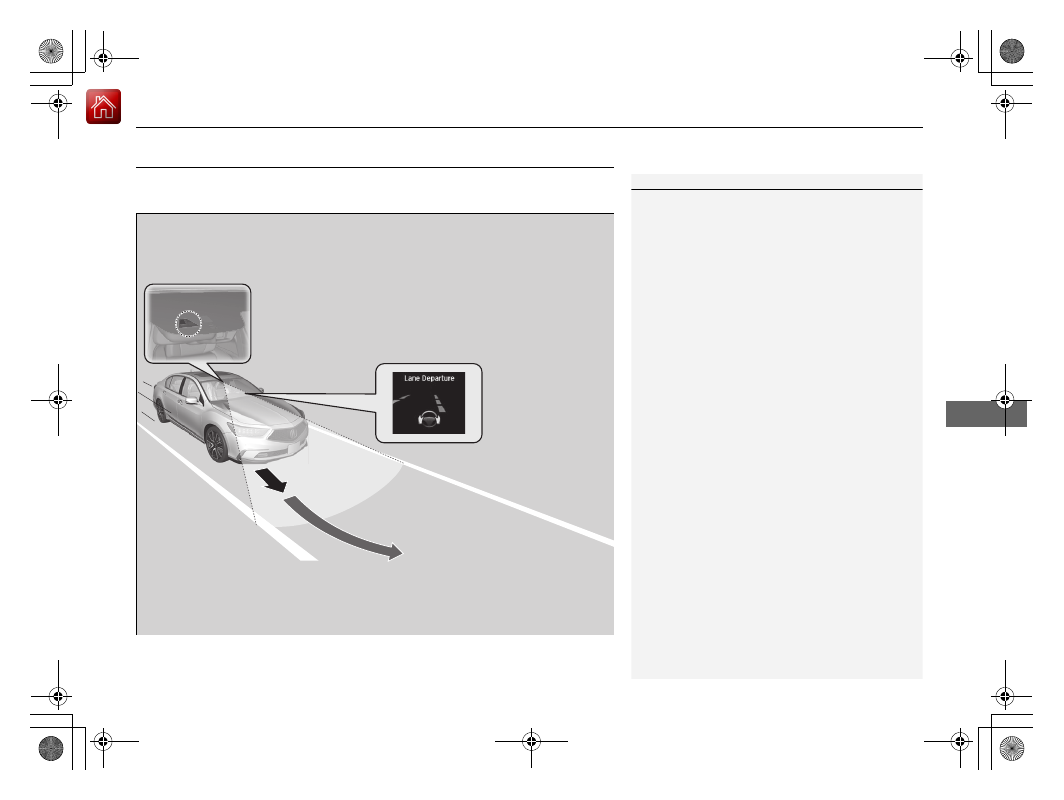
421
uu
When Driving
u
Lane Keeping Assist System (LKAS)
Continued
Driving
Lane Keeping Assist System (LKAS)
Provides steering input to help keep the vehicle in the middle of a detected lane and
provides tactile and visual alerts if the vehicle is detected drifting out of its lane.
1
Lane Keeping Assist System (LKAS)
Important Safety Reminders
The LKAS is for your convenience only. It is not a
substitute for your vehicle control. The system does
not work if you take your hands off the steering
wheel or fail to steer the vehicle.
2
Multi-Information Display Warning and
Information Messages
P. 94
Do not place objects on the instrument panel.
Objects may reflect on the front windshield and
prevent correct detection of the traffic lanes.
The LKAS only alerts you when lane drift is detected
without a turn signal in use. The LKAS may not detect
all lane markings or lane departures; accuracy will
vary based on weather, speed, and lane marker
condition. It is always your responsibility to safely
operate the vehicle and avoid collisions.
The LKAS is convenient when it is used on freeways.
The LKAS may not work properly or may work
improperly under the certain conditions:
2
LKAS Conditions and Limitations
You can read about handling information for the
camera equipped with this system.
2
P. 400
When you operate the turn signals to change lanes, the system is suspended, and
resumes after the signals are off.
If you make a lane change without operating the turn signals, the LKAS alerts
activate, and torque is applied to the steering.
■
Front sensor
camera
Monitors the lane
lines
■
Tactile and visual alerts
Rapid vibrations on the steering
wheel and a warning display alert you
that the vehicle is drifting out of a
detected lane.
■
Steering input assist
The system applies torque to the steering to keep the vehicle between the left and
right lane lines. The applied torque becomes stronger as the vehicle gets closer to
either of the lane lines.
-------------------------------------------------------------------------------------------------------------------------------------------------------------

uu
When Driving
u
Lane Keeping Assist System (LKAS)
422
Driving
Provides assistance to keep the vehicle in the center of the lane. When the vehicle
nears a white or yellow line, steering force of the electric power steering will become
stronger.
When the vehicle enters the warning area, the LKAS alerts you with slight steering
wheel vibration as well as a warning display.
■
Lane Keep Support Function
1
Lane Keeping Assist System (LKAS)
The LKAS may not function as designed while driving
in frequent stop and go traffic, or on roads with
sharp curves.
When it fails to detect lanes, the system will
temporarily be canceled. When lane is detected,
system will recover automatically.
■
Lane Departure Warning Function
Warning Area
Warning Area
-------------------------------------------------------------------------------------------------------------------------------------------------------------
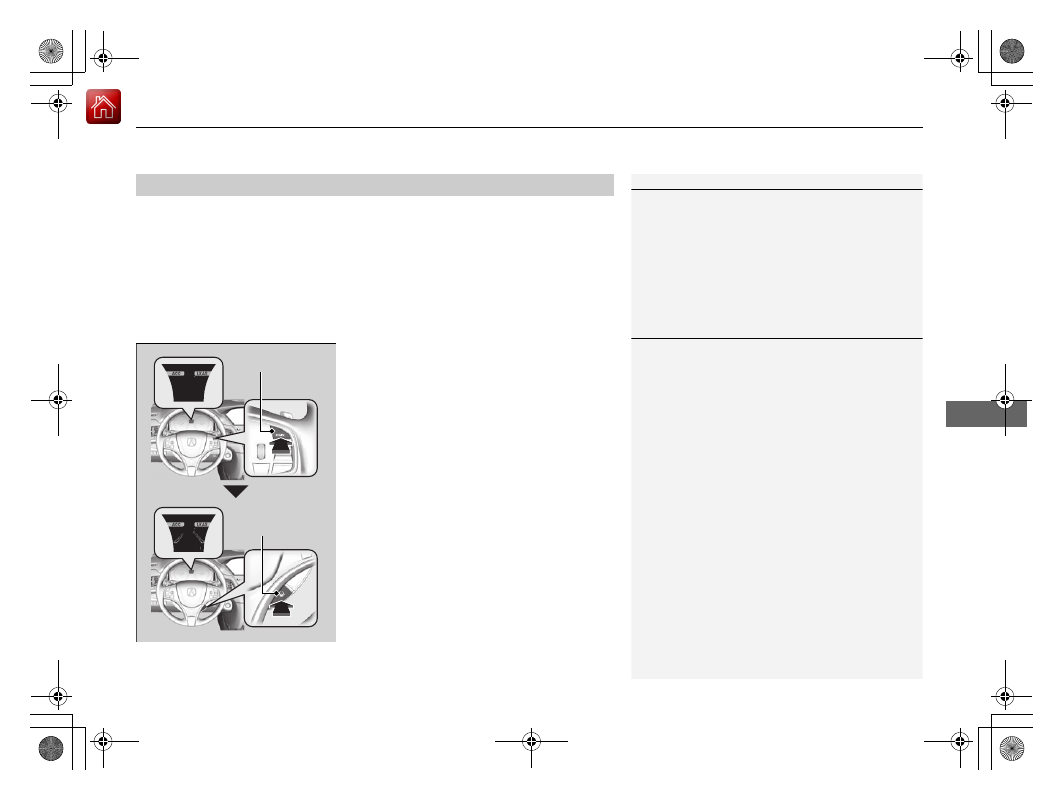
Continued
423
uu
When Driving
u
Lane Keeping Assist System (LKAS)
Driving
The system can be used when the following conditions are met.
•
The lane in which you are driving has detectable lane markers on both sides, and
your vehicle is in the center of the lane.
•
The vehicle speed is between 45 and 89 mph (72 and 144 km/h).
•
You are driving on a straight or slightly curved road.
•
The driver is gripping the steering wheel.
■
How to activate the system
1.
Press the
MAIN
button.
u
The
LKAS
indicator comes on in the
multi-information display.
The system is ready to use.
2.
Press the LKAS button.
u
Lane outlines (dotted outer lines) appear
on the multi-information display.
The system is activated.
■
When the System can be Used
1
If the vehicle drifts toward either left or right lane line
due to the system applying torque, turn off the LKAS
and have your vehicle checked by a dealer.
1
You can have the head-up display show you the
current state of Traffic Jam Assist.
2
MAIN
Button
LKAS Button
-------------------------------------------------------------------------------------------------------------------------------------------------------------

uu
When Driving
u
Lane Keeping Assist System (LKAS)
424
Driving
3.
Keep your vehicle near the center of the
lane while driving.
u
The dotted outer lines change to solid
ones once the system starts operating
after detecting the left and right lane
markings.
To cancel the LKAS:
Press the
MAIN
or LKAS button.
The LKAS is turned off every time you turn the
power system off, even if you turned it on the
last time you drove the vehicle.
■
To cancel
1
Pressing the
MAIN
button also turns ACC with Low
Speed Follow on and off.
MAIN
Button
LKAS Button
-------------------------------------------------------------------------------------------------------------------------------------------------------------
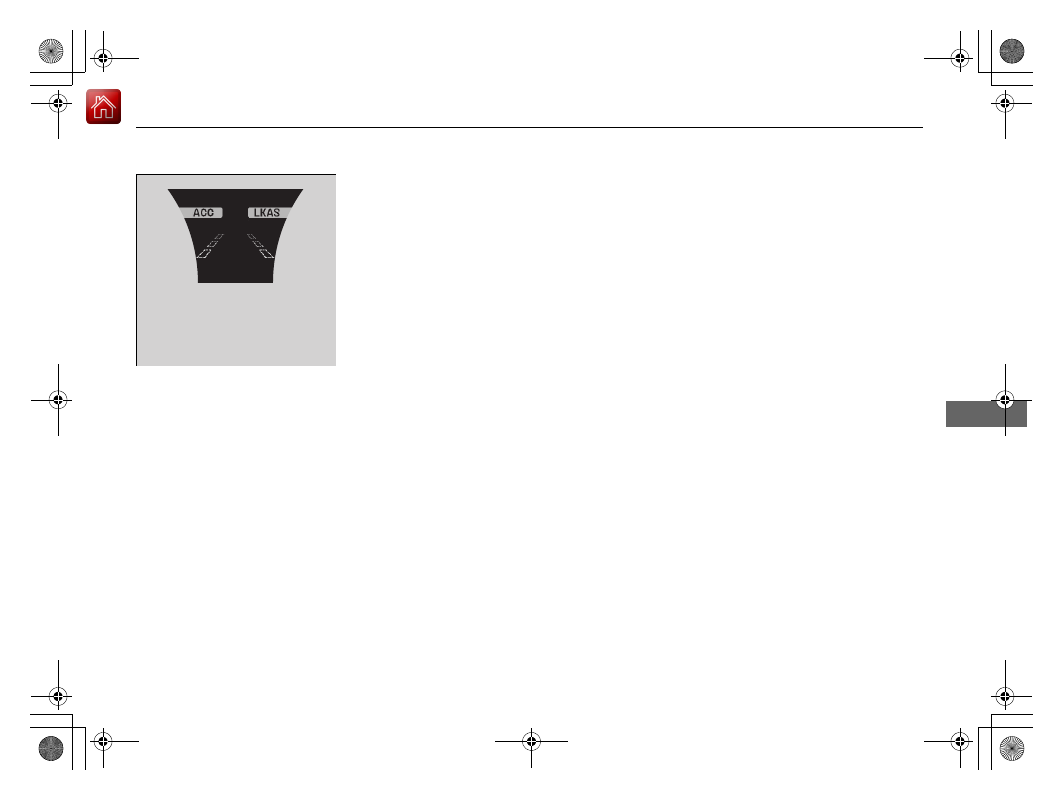
425
uu
When Driving
u
Lane Keeping Assist System (LKAS)
Continued
Driving
■
The system operation is suspended if
you:
•
The wipers are set to
HI
.
u
Turning the wipers off resumes the
LKAS.
•
Decrease the vehicle speed to about 40
mph (64 km/h) or less.
u
Increasing the vehicle speed to about 45
mph (72 km/h) or more resumes the
LKAS.
•
Depress the brake pedal.
u
The LKAS resumes and starts detecting
the lane lines again once you release the
brake pedal.
•
Your vehicle is driving to the right or the left
of the lane.
■
The LKAS may automatically be suspended when:
•
The system fails to detect lane lines.
•
The steering wheel is quickly turned.
•
You fail to steer the vehicle.
•
Driving through a sharp curve.
•
Driving at a speed in excess of approximately 89 mph (144 km/h).
Once these conditions no longer exist, the LKAS automatically resumes.
When the LKAS is suspended,
the lane lines on the multi-
information display change to
dotted lines, and the beeper
sounds (if activated).
-------------------------------------------------------------------------------------------------------------------------------------------------------------
426
uu
When Driving
u
Lane Keeping Assist System (LKAS)
Driving
■
The LKAS may automatically be canceled when:
It is possible that under any of the following circumstances, dotted outer lines will
appear on the multi-information display, a buzzer will sound, and LKAS will be
canceled automatically.
•
The camera temperature gets extremely high or low.
•
The camera behind the rearview mirror, or the area around the camera, including
the windshield, gets dirty.
•
The ABS or VSA
®
system engages.
The beeper sounds if the LKAS is automatically canceled.
The system may not detect lane markings and therefore may not keep the vehicle in
the middle of a lane under certain conditions, including the following:
■
Environmental conditions
•
Driving in bad weather (rain, fog, snow, etc.).
•
Sudden changes between light and dark, such as an entrance or exit of a tunnel.
•
There is little contrast between lane lines and the roadway surface.
•
Driving into low sunlight (e.g., at dawn or dusk).
•
Strong light is reflected onto the roadway.
•
Shadows are cast across the lane lines (e.g., trees, buildings, guardrails, vehicle,
etc.).
•
Roadway objects or structures are misinterpreted as lane markers.
•
Reflections on the interior of the windshield.
•
Driving at night or in a dark condition such as a tunnel.
■
LKAS Conditions and Limitations
-------------------------------------------------------------------------------------------------------------------------------------------------------------
427
uu
When Driving
u
Lane Keeping Assist System (LKAS)
Driving
■
Roadway conditions
•
The lines are not very distinguishable from the surface of the road.
•
Driving on a snowy or wet roadway (obscured lane marking, vehicle tracks,
reflected lights, road spray, high contrast).
•
Driving on a road with temporary lane markings.
•
Faint, multiple, or varied lane markings are visible on the roadway due to road
repairs or old lane markings.
•
The roadway has merging, split, or crossing lines (e.g., such as at an intersection
or crosswalk).
•
The lane markings are extremely narrow, wide, or changing.
•
The vehicle in front of you is driving near the lane lines.
•
The road is hilly or the vehicle is approaching the crest of a hill.
•
Driving on rough or unpaved roads, or over bumpy surfaces.
•
When objects on the road (curb, guard rail, pylons, etc.) are recognized as white
lines (or yellow lines).
•
Driving on roads with double lines.
■
Vehicle conditions
•
Headlight lenses are dirty or the headlights are not properly adjusted.
•
The outside of the windshield is streaked or blocked by dirt, mud, leaves, wet
snow, etc.
•
The inside of the windshield is fogged.
•
The camera temperature gets too high.
•
An abnormal tire or wheel condition (wrong sized, varied size or construction,
improperly inflated, compact spare tire
*
, etc.).
•
The vehicle is tilted due to a heavy load or suspension modifications.
•
The tires are equipped with snow chains.
* Not available on all models
-------------------------------------------------------------------------------------------------------------------------------------------------------------
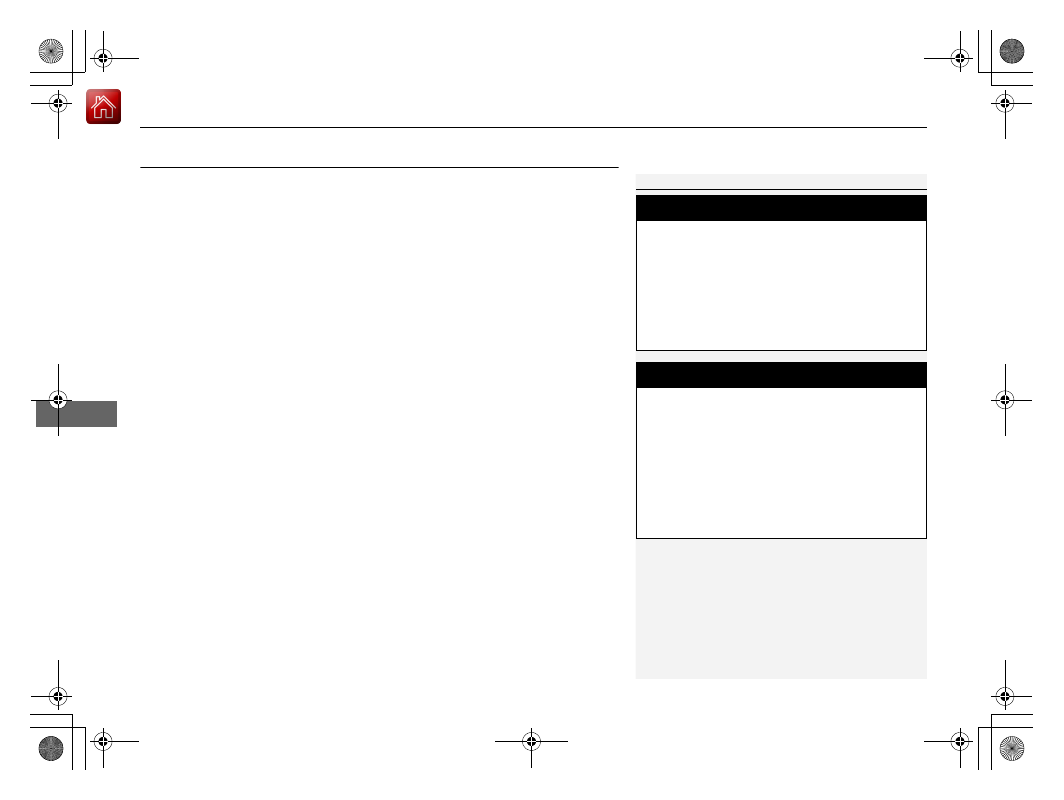
428
uu
When Driving
u
Traffic Jam Assist
Driving
Traffic Jam Assist
The traffic jam assist system uses a radar sensor mounted inside the front grille and
a camera mounted to the upper portion of the windshield to detect and monitor left
and right white (yellow) traffic lane lines as well as any vehicle ahead. Based on
inputs from the radar sensor and camera, the system adjusts the speed of your
vehicle to maintain a set interval between your vehicle and the one detected ahead.
It also applies steering torque to keep your vehicle in the center of the detected lane
when you are driving in heavy traffic.
■
How Traffic Jam Assist works
If you are in heavy traffic and Adaptive Cruise Control with Low Speed Follow is
active, the traffic jam assist system, upon detecting the traffic lane lines and a vehicle
ahead, will apply steering torque to help keep your vehicle in the center of the lane.
The system adjusts the speed of your vehicle to maintain a set interval between your
vehicle and the one detected ahead.
1
3
WARNING
Improper reliance on Traffic Jam Assist can
cause a crash resulting in injury or death.
Always maintain full control over your
vehicle even when this system is active. and
only use when on expressways or freeways.
Traffic Jam Assist is not an autonomous
driving system:
3
WARNING
Failure to securely park vehicle when
stopped using Adaptive Cruise Control with
Low Speed Follow is active can allow the
vehicle to roll away, resulting in an crash
causing injury or death.
Never stop the vehicle and exit it without
placing it in Park and setting the parking
brake.
-------------------------------------------------------------------------------------------------------------------------------------------------------------
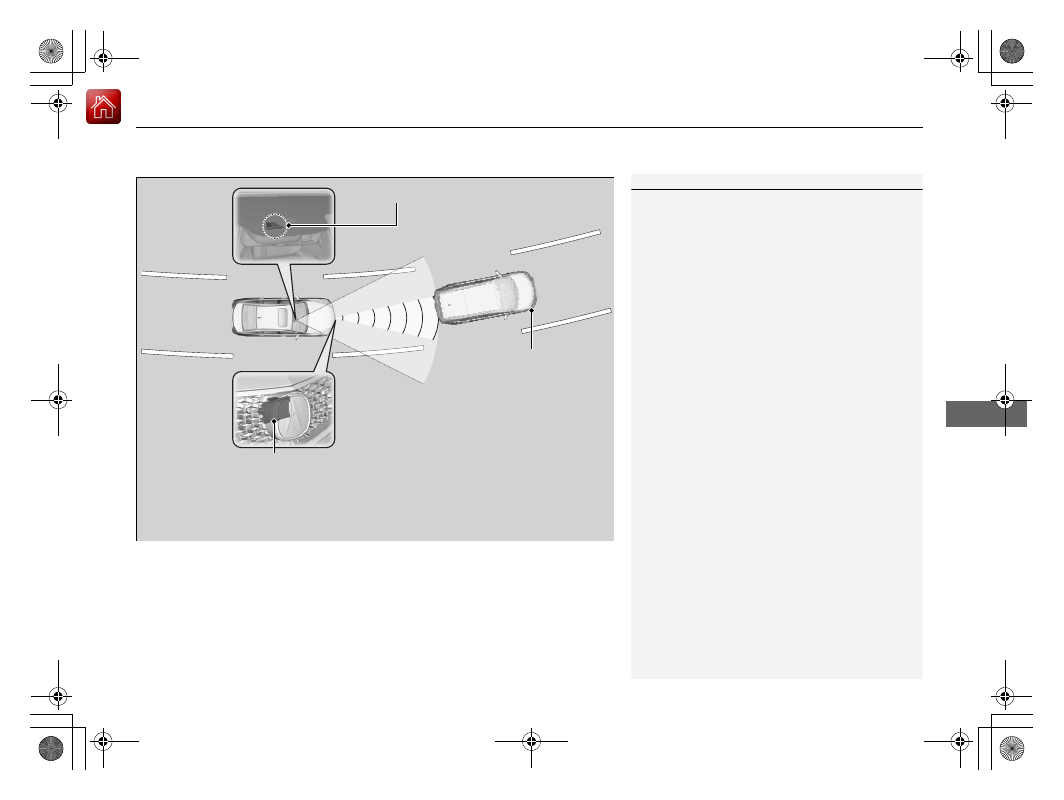
Continued
429
uu
When Driving
u
Traffic Jam Assist
Driving
When the driver takes direct control of steering, the steering assist function is
temporarily canceled.
The torque applied to steering may not be noticeable when the driver has direct
control of steering, or when the surface of the road is rough or uneven.
Front Sensor Camera
Detects vehicle
ahead
Detects left and right
white (yellow) traffic
lane lines
Radar Sensor
When you use the turn signal to indicate a lane change, Traffic Jam Assist is
temporarily deactivated. It is reactivated once the vehicle is traveling in the
center of the lane and the system has detected the traffic lane lines and a
vehicle ahead.
1
You can read about handling information for the
camera equipped with this system.
2
P. 400
Traffic Jam Assist may not always be able to detect
lane division lines or a vehicle traveling ahead.
Depending on weather and road conditions and
other factors, Traffic Jam Assist may not function
normally. Always be aware of your surroundings and
the road conditions, and conduct yourself in a
manner conducive to safe driving. Traffic Jam Assist
may not function properly when you are driving
through a sharp curve or repeatedly accelerating and
decelerating.
Traffic Jam Assist may not work properly under the
certain conditions:
2
-------------------------------------------------------------------------------------------------------------------------------------------------------------

uu
When Driving
u
Traffic Jam Assist
430
Driving
Traffic Jam Assist is activated when all of the following circumstances exist:
•
LKAS is activate.
•
ACC with Low Speed Follow is active.
•
The vehicle speed is between 0 and 45mph (0 and 72km/h) and there is a vehicle
detected traveling ahead.
•
The lane in which you are driving has detectable lane markers on both sides, and
your vehicle is in the center of the lane.
•
You are driving on a straight or slightly curved road.
•
The driver is gripping the steering wheel.
Do not use Traffic Jam Assist in any of the following situations:
•
You are traveling on a road with sharp curves.
u
The system may not allow your vehicle to respond in a manner best suited for
the road conditions.
•
You are entering a toll booth, interchange, service area, or parking area.
u
If the vehicle ahead disappears from the travel path of your vehicle, your
vehicle may suddenly accelerate to resume the set speed.
•
You are driving in adverse weather (rain, fog, snow, etc.).
u
The system may not be able to correctly determine the interval between your
vehicle and the one ahead.
•
The surface of the road is slippery, for example, it is icy or covered with snow.
u
The tires may slip, causing you to lose control of the vehicle.
•
You are driving in a HOV lane and motorcycles are passing you to the side, or you
are required to keep your vehicle to the right or the left of the lane.
u
The system may not be able to correctly determine the vehicle ahead.
■
Traffic Jam Assist Activation
1
Refer to the following page for proper handling of
the Adaptive Cruise Control with Low Speed Follow:
2
Adaptive Cruise Control (ACC) with Low
Speed Follow
P. 402
Refer to the following page for proper handling of
the Lane Keeping Assist System (LKAS):
2
Lane Keeping Assist System (LKAS)
P. 421
Refer to the following page for steering buttons and
displays:
2
-------------------------------------------------------------------------------------------------------------------------------------------------------------
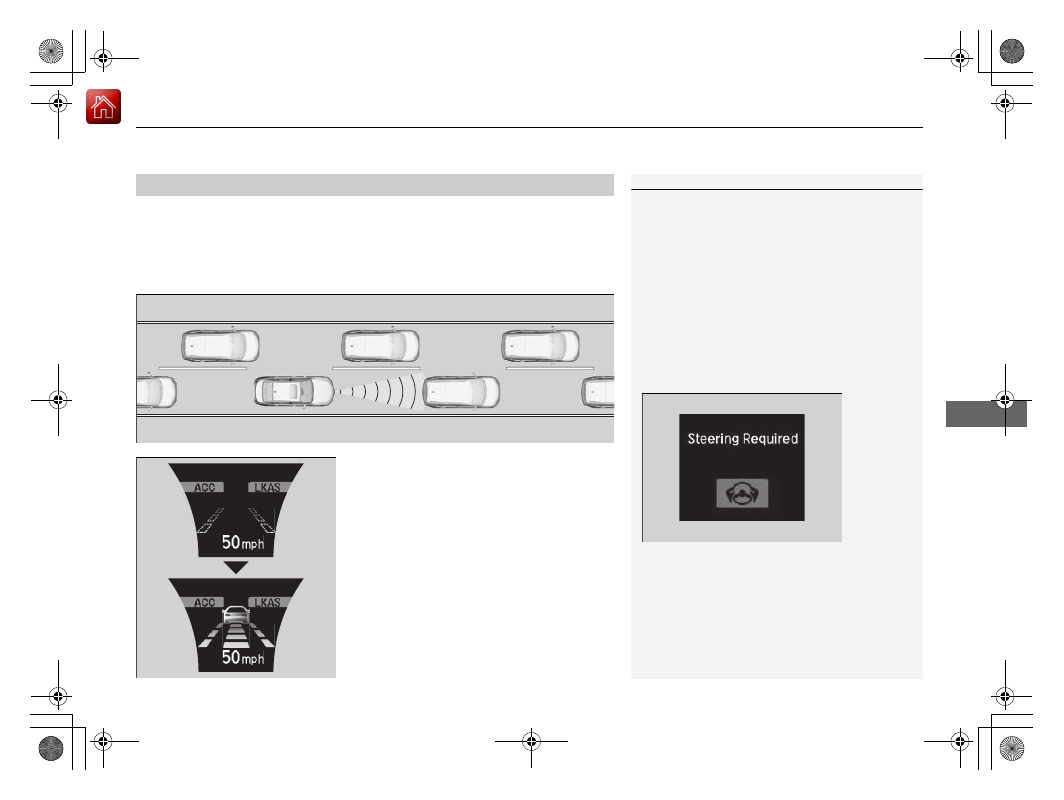
Continued
431
uu
When Driving
u
Traffic Jam Assist
Driving
■
When a vehicle is traveling ahead
When a vehicle ahead of yours is detected entering the Traffic Jam Assist detection
area, Traffic Jam Assist adjusts the speed of your vehicle to maintain the selected
interval between your vehicle and the one ahead. It also applies steering torque to
keep your vehicle in the center of the detected lane.
Keep your vehicle near the center of the lane
while driving.
u
Traffic Jam Assist will be activated once
the camera has detected the white
(yellow) traffic lane lines on either side of
the lane and the radar sensor and
camera have detected a vehicle driving
ahead.
The dotted outer lines change to solid
ones and a vehicle icon appears on the
multi-information display.
■
How Traffic Jam Assist Works
1
If your vehicle veers too far to the right or the left of
the white (yellow) traffic lane lines while Traffic Jam
Assist is active, deactivate Traffic Jam Assist and have
an authorized Acura dealer inspect your vehicle.
In some cases the system cannot properly detect the
traffic lane lines and, as a result, will not provide
steering assistance.
2
Traffic Jam Assist: Conditions and
limitations
If the driver takes his or her hands off the steering
wheel or does not adequately maintain control of
steering, the warning below will appear.
If the driver does not grip the steering wheel after the
warning above has repeatedly appeared, a warning
buzzer will sound and Traffic Jam Assist will be
canceled.
You can have the head-up display show you the
current state of Traffic Jam Assist.
2
Traffic Jam Assist has a detection range of 197 ft. (60m)
-------------------------------------------------------------------------------------------------------------------------------------------------------------

uu
When Driving
u
Traffic Jam Assist
432
Driving
■
When no vehicle is traveling ahead
If the vehicle detected ahead disappears from
the travel path of your vehicle (for example, it
changes lanes), Traffic Jam Assist will be
deactivated temporarily and your vehicle will
gradually accelerate until it reaches the set
speed, after which it will maintain that speed.
1
If the vehicle detected ahead suddenly slows down,
or if another vehicle is detected cutting in front of
yours, a warning buzzer will sound, and a warning in
the multi-information display and head-up warning
will appear.
Depress the brake pedal and take direct control of
steering.
Beep
Head-up Warning
The dotted outer lines and a
vehicle icon with a dotted-line
contour appear on the multi-
information display.
-------------------------------------------------------------------------------------------------------------------------------------------------------------
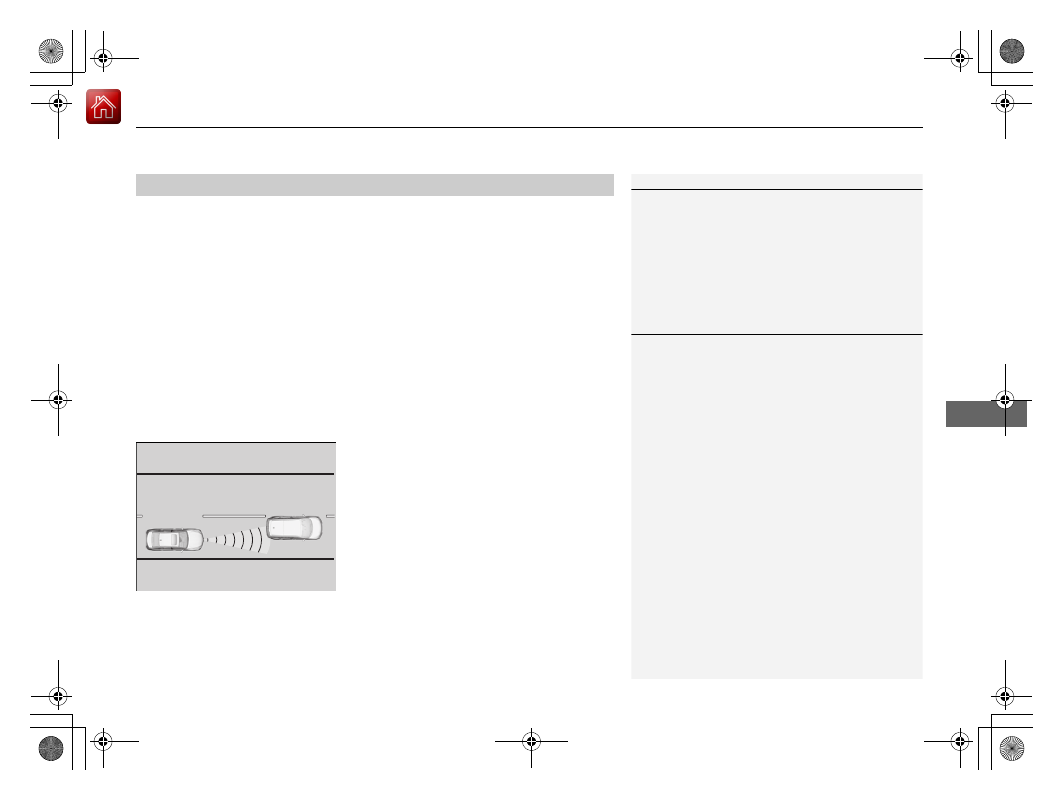
Continued
433
uu
When Driving
u
Traffic Jam Assist
Driving
To cancel Traffic Jam Assist, you can do any of the following:
•
Press the
MAIN
button.
•
Press the LKAS button.
•
When the ACC with Low Speed Follow is deactivated.
■
When Traffic Jam Assist may automatically be suspended when:
The system is temporarily canceled automatically under the following circumstances.
•
The system fails to detect lane lines.
•
The vehicle ahead of you cannot be detected.
•
The steering wheel is turned quickly.
•
You fail to steer the vehicle.
•
The vehicle in front of you is driving near the lane lines.
•
The wipers are set to high.
•
The interval between your vehicle and the one traveling ahead is over 197 feet
(60m).
Once these conditions no longer exist, the Traffic Jam Assist automatically resumes.
■
Canceling Traffic Jam Assist
1
If you are traveling slower than the vehicle detected
ahead or a vehicle that is detected cutting in front of
you and the interval between your vehicle and the
detected vehicle gradually increases, your vehicle will
continue to follow that vehicle without emitting any
warning, even if the interval between the vehicle is
minimal.
1
When Traffic Jam Assist may automatically be suspended when:
You are traveling over 45mph (72km/h).
u
When the speed of the vehicle reaches 45mph
(72km/h), Traffic Jam Assist is deactivated and LKAS
is activated instead. Once the speed of the vehicle
drops to under 42mph (68km/h), Traffic Jam Assist
is reactivated.
-------------------------------------------------------------------------------------------------------------------------------------------------------------

Нет комментариевНе стесняйтесь поделиться с нами вашим ценным мнением.
Текст